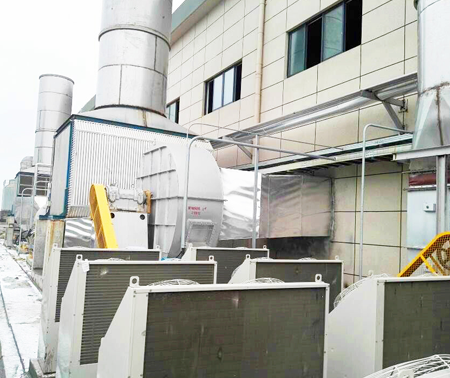The performance of the ventilation system in the dry operation department has seriously affected the operational efficiency, production energy consumption, and product quality of the paper machine. Due to the continuous increase in the speed of the paper machine, the airflow organization inside the drying section hood is becoming increasingly complex, and the difficulty of handling incoming air is also increasing. As a key equipment for airflow organization and air treatment, the closed hood is of high value in the ventilation system of the paper machine and has played a crucial role in the operation of the paper machine. The efficiency of the enclosed hood directly affects the normal operation of the paper machine.
The main parameter of the ventilation system design for the drying section is the humidity of the water vapor discharged from the hood. The structural form and sealing performance of the hood have a significant impact on the humidity of the water vapor discharged from the hood. Low humidity operation of cadres requires high exhaust volume and high air supply volume. A reasonable structural form and good sealing performance are the guarantees for efficient gas hoods. So, what are the structural characteristics of open hood and closed hood?
1. Open top cover hood
This is a relatively simple form of hood, which is to install a top cover above the dry part. Many covers are only made of low adiabatic value sheets and require a high exhaust volume to prevent condensation. Additional insulation panels are also used to provide better insulation performance, with a slight increase in humidity. These types of hoods are generally not tightly assembled to the drying section, and leakage is a major issue. In order to capture water vapor and prevent condensation, the design value of exhaust volume is very large.
The exhaust humidity range of the open top cover hood design is 0.04-0.07kg evaporated water/kg air. The humidity of the simple cover exhaust is about 0.04kg evaporated water/kg dry air. The exhaust humidity of a simple cover with insulation protection board is about 0.07kg of evaporated water/kg of air. Every 1kg of water evaporated requires approximately 13kg of air, which increases energy consumption due to the high air flow rate passing through the cadres. High exhaust volume must be balanced with the supply air volume of the heating building, thereby increasing the heat load of the building. Low exhaust temperature also increases the cost of heat recovery, which is mostly not advisable. Open hoods are rarely used on new paper machines. Many old paper machines still use open hoods. They are gradually being replaced by more efficient enclosed gas emeralds.

2. Medium humidity airtight hood
This type of hood is commonly used in North America. The air hood is composed of an insulated dense cover on the operating floor, with a lifting screen at the front and a sliding screen at the back as the inlet and outlet for the drying section on the operating floor. The hood also includes a sealed bottom plate without insulation on the bottom surface of the drying section. The function of a sealed bottom plate is to prevent air leakage from the bottom plate. If there is no dense base plate, the sealing air hood on the operating floor will be "pressurized". The natural chimney effect in the drying section causes the "opening pressure" effect, and the bottom sealing plate can limit the airflow and prevent the pressure increase effect. In the early design of the closed hood, the exhaust humidity was about 0.09kg of evaporated water/kg of dry air. Most medium humidity atmospheres currently operate within the range of 0.11 to 0.13kg/kg, with approximately 10kg of air discharged per kg of water evaporated. The typical exhaust temperatures for this type of hood are 80 ℃ dry bulb temperature and 59 ℃ wet bulb temperature. The heat recovered by a medium humidity enclosed hood is usually very attractive to the northern climate. Its heat recovery is commonly used for preheating the hood for air supply, heating production water, and heating buildings to supplement air.
3. High humidity enclosed hood
The overall structure and layout of a high humidity closed hood are basically the same as that of a medium humidity closed hood, but there is more emphasis on manufacturing and material selection. The insulation board with groove joint used in medium humidity sealed gas hoods is not suitable for long-term use in high humidity environments, and there are issues with poor sealing and sea leakage. High humidity sealed gas hoods use materials such as high insulation value boards and high-temperature resistant rubber, and can be well sealed. Basically solved the problems of poor sealing of the lifting door of the medium humidity airtight hood and gas leakage. High humidity enclosed hood can reduce energy consumption and is very conducive to heat recovery. The exhaust humidity of the high humidity sealed hood design is approximately 0.16~0.17 kg water/kgd. a. The typical exhaust temperatures for evaporating 1kg of water and consuming about 7kg of air are 85C ℃ dry bulb temperature and 62 ℃ wet bulb temperature. The main advantage of a high humidity sealed hood is to reduce the air flow through the hood and the impact of air flow on the operation of the paper. It can better control the air flowing through the drying section to meet the needs of high-speed paper machine operation.
The paper machine drying section is equipped with an efficient sealed hood, which can improve the production environment, reduce production energy consumption, and improve paper machine efficiency and product quality. At present, domestic and foreign paper machine manufacturers have applied a large number of new technologies and materials in the ventilation and hood design of the drying section of paper machines, making the performance of the ventilation system and hood of the drying section of paper machines increasingly perfect to meet the needs of efficient and high-speed paper machine operation.
That's all for today's introduction of open hood and closed hood. Follow Fengxin Technology to learn more about hood knowledge.
![]()
| Mobile: + 86-15965759999 | |
| Tel.: + 86-0635-2531988 | |
| Email: fengxin@cnfengxin.cn | |
| Address: Hi tech Industrial Park, Linqing City, Shandong Province (shilitun, Xinhua office) |
